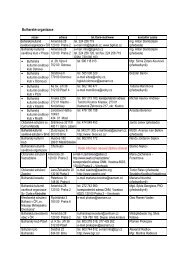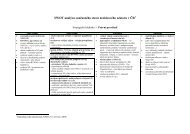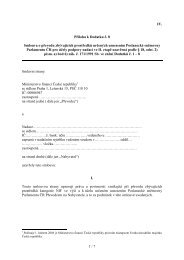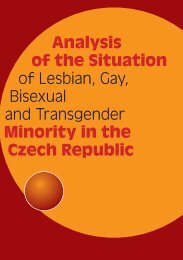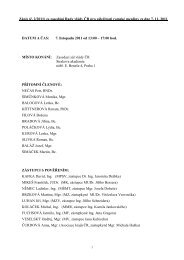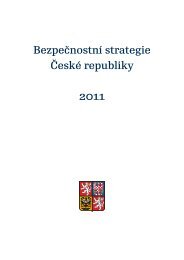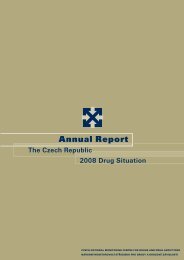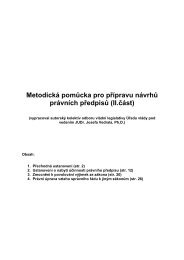The Czech Republic Annual Report 2010 Drug ... - Drogy-info.cz
The Czech Republic Annual Report 2010 Drug ... - Drogy-info.cz
The Czech Republic Annual Report 2010 Drug ... - Drogy-info.cz
Create successful ePaper yourself
Turn your PDF publications into a flip-book with our unique Google optimized e-Paper software.
cannabis, especially among adolescents and young adults, is also confirmed by data from general population<br />
surveys; see the chapter on <strong>Drug</strong> Use in the General Population (p. 28).<br />
<strong>The</strong> greatest number of people demanding treatment in <strong>2010</strong> stated that they were injecting drug users, followed by<br />
smoking (13.9%) and inhaling/snorting (12.3%).<br />
In <strong>2010</strong>, those making their first treatment demands reported the daily use of drugs in 1,308 cases (30.0%); an<br />
additional 1,013 users (23.2%) used a drug 2–6 times per week. Heroin was most frequently used daily by newly<br />
recorded users (54.8%). Pervitin was used on a daily basis by 23.7% of people demanding treatment for the first<br />
time; the most widely-reported frequency of use of pervitin was 2–6 times per week (27.8%). All those making<br />
treatment demands reported the daily use of drugs in 2,731 cases (30.3%); an additional 1,930 users (21.4%) used<br />
a drug 2–6 times per week. Among all heroin users in treatment, about half of those demanding treatment reported<br />
daily use. Among pervitin users, a lower frequency of use was more common, at several times per week (25.4%) as<br />
opposed to daily use (21.9%). <strong>The</strong> majority of buprenorphine users (63.3%) also reported daily drug use in their<br />
demand for treatment (Studničková and Petrášová, 2011).<br />
<strong>The</strong> socioeconomic characteristics of those demanding treatment have changed little over the past years. Out of the<br />
total of 9,005 treatment demands in <strong>2010</strong>, 13.6% were from homeless people and another 9.7% were from people<br />
residing in institutions (e.g. prisons, institutional care, hostels, or sheltered housing); only 45.3% gave a permanent<br />
address. A third of all registered drug users in treatment live with their parents; 21.3% of all clients in treatment stated<br />
that they live alone, with 19.3% of newly registered clients living alone; 666 drug users in treatment (7.4%) stated that<br />
they live with children (for more <strong>info</strong>rmation on the issue of drug-using parents and pregnant drug users see the<br />
selected issue chapter on <strong>Drug</strong> Users with Children, p. 148). <strong>The</strong> number of people without a permanent home is<br />
significantly greater among repeatedly treated and long-term drug users than among those demanding treatment for<br />
the first time. <strong>The</strong> percentage of homeless people has been increasing among all clients and first-time demands<br />
since 2006 (Studničková and Petrášová, 2011).<br />
More than a half of treatment demands were from unemployed people or people with temporary jobs (57.0%). A total<br />
of 13.4% of first-time treatment demands and 16.0% of all treatment demands were from people who stated they<br />
had regular employment. Nearly half of treatment demands were from people who had just a basic education, and<br />
45.4% had completed secondary school (Studničková and Petrášová, 2011).<br />
In <strong>2010</strong>, 8,232 treatment demands (91.4% of all treatment demands) and 3,827 first treatment demands (87.7%)<br />
were from drug users classified under the definition of problem users 80 . <strong>The</strong>re is a persistently high share of injecting<br />
drug users among treatment demands – a total of 6,284 demands (69.8% of all demands) and 2,695 first-time<br />
demands (61.8%) stated that they were injecting drug users, a slight increase compared to 2009. Trends for selected<br />
characteristics among those demanding treatment are shown in Figure 5-7 and Figure 5-8. Further <strong>info</strong>rmation about<br />
injecting drug users among those demanding treatment is provided in the chapter on Risk Behaviour of <strong>Drug</strong> Users<br />
(p. 90).<br />
As was the case in 2009, the typical profile for a client in treatment in <strong>2010</strong> is an unemployed male of <strong>Czech</strong><br />
nationality between 25 and 30 years of age, who has completed his basic education, from Prague or Central<br />
Bohemia, with a permanent place of residence, living alone or with his parents, and using stimulants (pervitin). He<br />
uses the drug several times per week, mostly by injecting.<br />
80<br />
<strong>The</strong> EMCDDA defines problem drug use as injecting drug use and/or the long-term/regular use of opiates and/or amphetamine-type<br />
drugs and/or cocaine (European Monitoring Centre for <strong>Drug</strong>s and <strong>Drug</strong> Addiction, 2009). Cocaine use in the <strong>Czech</strong> <strong>Republic</strong> is at a very<br />
low level. <strong>The</strong> prevalence of problem cocaine use has not been estimated; for more <strong>info</strong>rmation see the chapter on Problem <strong>Drug</strong> Use<br />
(p. 48).<br />
page 72




